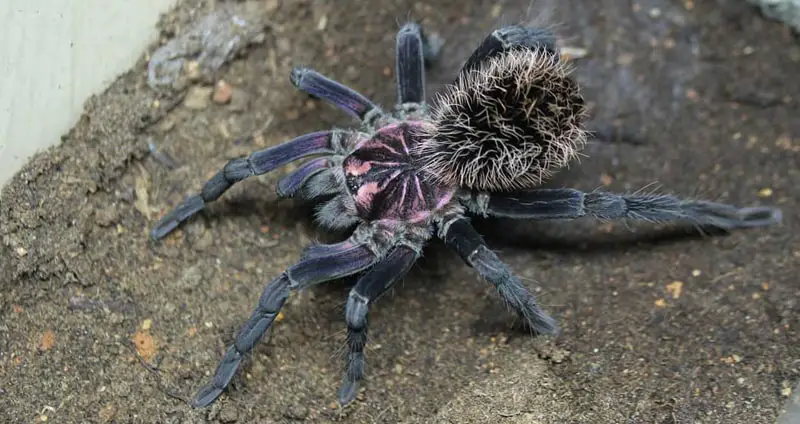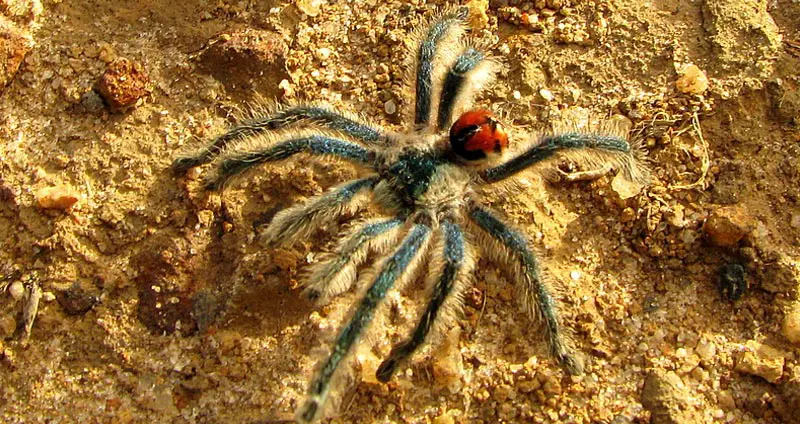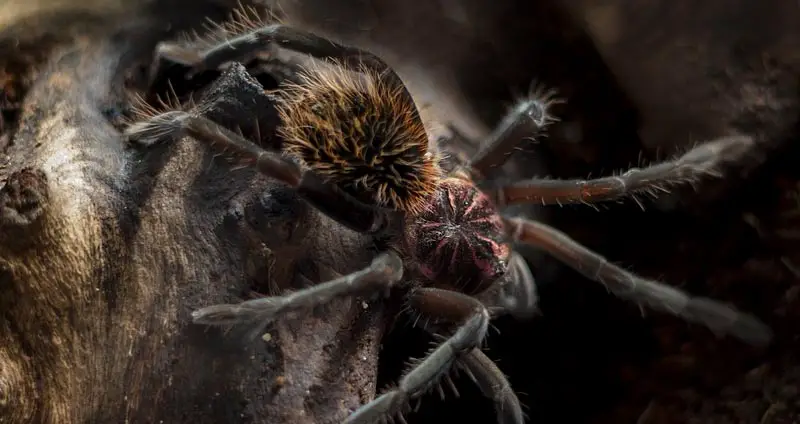Xenesthis immanis, or the Colombian Lesserblack tarantula, is definitely one of the most noteworthy of the over 800 tarantula species in existence today. Its incredible appearance, unique personality, and large size makes it stand out from the rest with ease.
If you’re looking to bring home one of these tarantulas, you’ll need to know how to properly care for them. This care sheet will tell you everything that you need to know about their feeding, housing, and what can you expect with owning one of them.
Table of Contents
Xenesthis immanis Care Sheet
| | |
Common Name |
Colombian Lesserblack |
Species Type |
New world terrestrial |
Natural Habitat |
Found in Panama, Brasil, Colombia, Venezuela, Ecuador, and Peru — temperate climates with very high humidity year-round. |
Growth Rate |
Medium-to-fast growth rate, growing up to 4″ in a year. |
Adult Size |
Both females and males achieve around an 8″ legspan. Females are more heavy-bodied. |
Lifespan |
Females live about 15 years while males live up to 4. |
Enclosure |
The enclosure should be wider than it is tall with an emphasis on floor space. 6 inches of substrate should line the floor of the enclosure, and a hide and water dish need to be present. |
Temp/Humidity |
75°F to 80°F with about 70% to 80% humidity. |
Diet |
A great eater that devours its prey aggressively. Adults can eat about 6 adult crickets per week. |
Temperament |
Overall a docile tarantula. Will throw up threat poses, but prefers to flee instead of kicking hairs. Gets more calm as it ages. |
Experience Level |
Intermediate – Very easy to care for due to its temperament and burrowing tendencies. However, it is quite large and expensive. |
Average Cost |
Slings ~ $100, Males ~ $400, Females ~ $700+ |
Xenesthis immanis Appearance
X. immanis is prized for its fuzzy appearance with prominent color variations on its torso, carapace, and legs. When fully grown, the adult Colombian Lesserblack will reach a leg span of up to 8 inches, featuring darker hues throughout.
Older males will have a characteristic black purple carapace, with bright golden hairs across the abdomen. In fact, males are significantly more stunning than females.
The Colombian Lesserblack tarantula lacks the stridulating organs at the base of their first leg and palpi, just like the Pamphobeteus spp. and Megaphobema spp., but they can be easily distinguished by the scopulae on their fourth leg. All Xenesthis immanis have larger scopulae on the inner side of the fourth leg’s femur.
It is worth noting that the spiderlings are born surprisingly large and won’t take long to resemble adults at 8 inches if they’re properly cared for and fed. Females can live up to 15 years, while males only live for 4 years.

via @soo_spider / Instagram
Xenesthis immanis Temperament
The Colombian Lesserblack is a new-world tarantula and is very shy as a juvenile, but they have been observed to grow less skittish once they’re close to fully-grown. This doesn’t mean they are aggressive at all — they’re just more confident.
X. immanis would defend itself if necessary when spooked or pushed into a corner. They will try to warn predators (and handlers) by throwing defensive poses as a threat, but their first course of action would be to retreat rather than fighting back.
While these tarantulas virtually never bite, they are relatively fast and possess the ability to flick hairs. It’s because of this that handling isn’t recommended, as it could result in the unintended harm of your tarantula.
In the wild, Xenesthis immanis will try to find cover from harsh weather by burrowing rather extensively. They maintained this burrowing behavior even in captivity, although they do spend a good amount of time above the ground on display, too.
Housing Xenesthis immanis
This is a larger tarantula species that loves to take advantage of all of the space that it’s given, so you should aim to provide it with a larger enclosure.
Other than that, there aren’t many other special requirements that Xenesthis immanis has.
Optimal Xenesthis immanis Enclosure
This is a terrestrial tarantula species, so their enclosure should have a large focus on floor space for them to roam around on. Since they’re so large, we recommend either the Exo Terra 18″ x 18″ x 12″ glass terrarium or the Repti Zoo 20″ x 12″ x 10″ enclosure.
Both of these enclosures are plenty large enough for this tarantula, have great visibility and accessibility, and allow for good cross-ventilation — something that’s very important for this species.
The larger size of these enclosures allows for the formation of intricate burrows and webbing and plenty of room to walk around.
Enclosure Decorations
There are a few supplies you need when designing the enclosure. The most important of these is to add up to 6 inches of a slightly moist substrate on the ground.
Xenesthis immanis typically burrows under logs and stones, so make sure to place a sizable tarantula hide on the surface — one that can fully conceal the tarantula. This gives the Colombian Lesserblack a convenient place to retreat to when nervous.
Make sure to add a large water dish to the enclosure as well. This keeps the tarantula hydrated and helps to maintain the high humidity levels that are required.
Fake plants can also be added to spruce up the enclosure. Live plants aren’t recommended as they require too much light and will be difficult to properly care for.
Enclosure Humidity/Heating
Xenesthis immanis is found in Panama, Brasil, Colombia, Venezuela, Ecuador, and Peru — all countries with high temperatures and humidities for most of the year.
The natural habitat of this species is relatively warm, with temperatures around 75°F to 80°F year-round. This is close to room temperature for most people, so heating wouldn’t need to be actively maintained.
However, if your house drops below this range, you may need to provide supplemental heating through the use of a space heater.
In terms of humidity, this species thrives around 70% to 80% humidity. These levels can be maintained through the spraying of substrate with water and keeping it slightly damp. The water dish in the enclosure can also be over-filled to dampen the substrate around it.
This is a very high humidity level, so it’s important to not let your Xenesthis immanis enclosure become swampy. Enclosures that are too moist can cause problems. Therefore, you should monitor conditions with a simple thermometer/hygrometer.
Diet
The spiderlings are already born large from the get-go and have a voracious appetite. Pinhead crickets are perfect for slings before they start to gain some size.
Once they grow to an appreciable length, introduce them to adult dubia roaches and adult crickets several times per week. These spiders will gobble up their prey in no time, always putting on a show for you.
Don’t worry about overfeeding this species. Just make sure to clean up after them. As a general rule, try increasing their feeding times if they always seem to be in a feeding frenzy.
Try rewarding them with a pinkie mouse or house gecko every couple of months. They will never refuse to eat unless molting.
Health Concerns
Captive pet tarantulas rarely, if ever, experience health problems. As long as their enclosure is properly maintained and they’re fed a good diet, they should be totally healthy.
It isn’t unheard of for captive tarantulas to experience dehydration and parasite/mite infestations. Fortunately, both of these things are easily remedy or avoid altogether.
Once again, it’s important to keep a watchful eye on the humidity of your X. immanis enclosure. If humidity levels get too high or low, it could have serious repercussions.
Xenesthis immanis For Sale & Price
Because they are a stunning bird spider with an exotic appearance, the X. Immanis will fetch a heavy price tag, ranging from $100 for a very small sling to over $700 for a mature sexed female.
Some specimen with very unique coloration can actually fetch over $1000. This makes them one of the most expensive tarantulas in existence today — but for a very good reason!
Despite the cost, these spiders are a must-have for your collection. Their absolutely brilliant appearance makes them a great display tarantula, and their care requirements are surprisingly basic.

